Chairman's Desk
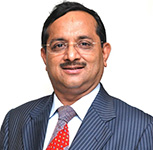 |
| SHRI SATISH W. WAGH |
| Chairman, CHEMEXCIL |
|
| |
Dear Member-exporters,
I have pleasure to bring to you the 13th issue of the CHEMEXCIL e-Bulletin for the month of May 2017, which contains the following activities undertaken by the Council and other useful information/Notifications, etc.
- Office of Chief Commissioner Service Tax, Mumbai informed CHEMEXCIL to conduct aHalf day Seminar on “GST Trade Awareness” which was held on 9th May, 2017 at Hotel Marine Plaza in Mumbai. The topics covered by the officers were Introduction to GST, Overview of GST, Registration, Returns, Refunds, and GSTN etc. The seminar was a huge success.
- Brief discussion regarding Stakeholders Consultation Meeting on Free Trade Agreement between the Eurasian Economic Union (EAEU) and India held at EEPC India Conference Hall, “VanijyaBhavan” on 11th of May, 2017. This was conducted by DGFT jointly with CAPEXIL, CHEMEXCIL, SHEFEXIL, PLEXCONCIL, TEA BOARD and Ministry of Commerce and Industry (Govt. of India).
I hope that you would find the newsletter informative and useful. The Secretariat looks forward to receiving your valuable feedback and suggestions so as to enable us to improve this e-bulletin further.
With regards,
SHRI SATISH W. WAGH
Chairman,
CHEMEXCIL
|
BACK |
Seminar on "GST Trade Awareness” at Hotel Marine Plaza, Mumbai on 9th May 2017
As we all know, GST which is the biggest tax reform post-independence is likely to be implemented soon. In this regard, the Office of Chief Commissioner, Service Tax, Mumbai had contacted us for organizing a half day seminar on "GST Trade Awareness".
For the benefit of member-exporters, the seminar was organized by the council at Hotel Marine Plaza, Mumbai on 9th May 2017 jointly with DMAI.
The O/o Chief Commissioner, Service Tax, Mumbai had deputed following officers as faculty for conducting the seminar:
- Shri Yogesh Loke, Asst. Commissioner, ST-II, Mumbai
- Ms. Priya Jadhav, Asst. Commissioner , ST-1, Mumbai
Further, Shri Abhay Udeshi, Chairman- Castor Oil & Speciality Chemicals Panel of Chemexcil, Shri Bharat Mehta, Chairman, Merchant Exporters Panel of Chemexcil and Mr. C.K Singhania, Hon. Secretary-DMAI also attended Seminar.
The officers of the Service Tax Department covered important topics such as -Introduction to GST, Overview of GST, Registration, Returns, Refunds, and GSTN etc.
The Seminar got excellent response with 66 Member Exporters of CHEMEXCIL/ DMAI attending the event. The participants asked several queries during the seminar which were answered satisfactorily by the officers of the Service Tax Dept.
| Glimpses of the Seminar |
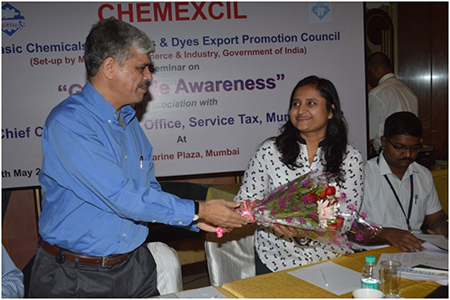 |
| Shri Abhay Udeshi, Chairman- Castor Oil & Speciality Chemicals Panel of Chemexcil welcoming Ms.Priya Jadhav, Asst. Commissioner, ST-1, Mumbai during GST Trade Awareness Seminar at Hotel Marine Plaza, Mumbai on 9th May 2017. |
| |
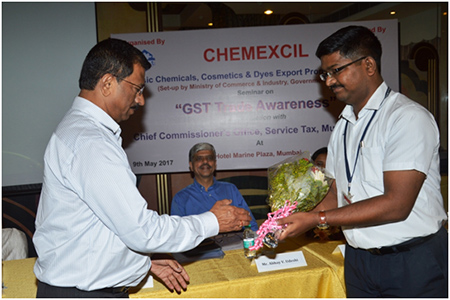 |
| Shri S.G Bharadi, ED Chemexcil welcoming Shri Yogesh Loke, Asst. Commissioner, ST-II, Mumbai during the GST Trade Awareness Seminar at Hotel Marine Plaza, Mumbai on 9th May 2017 |
| |
 |
| Shri Abhay Udeshi, Chairman- Castor Oil & Speciality Chemicals Panel of Chemexcil addressing the gathering during GST Trade Awareness Seminar at Hotel Marine Plaza, Mumbai on 9th May 2017. |
| |
 |
| Shri Yogesh Loke, Asst. Commissioner, ST-II, Mumbai and Ms. Priya Jadhav, Asst. Commissioner , ST-1, Mumbai making presentation during GST Seminar |
| |
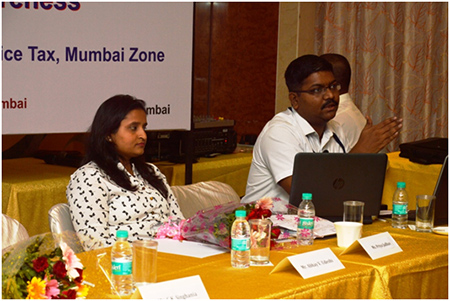 |
| Shri Yogesh Loke, Asst. Commissioner, ST-II, Mumbai and Ms. Priya Jadhav, Asst. Commissioner , ST-1, Mumbai answering queries of the participants |
| |
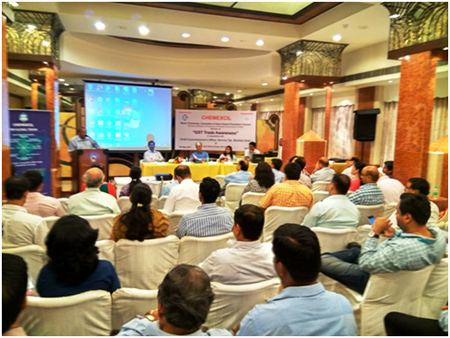 |
| Shri CK Singhania, Hon Secretary, DMAI addressing the gathering at the GST Trade Awareness Seminar at Hotel Marine Plaza, Mumbai. |
| |
 |
| Participants asking queries during the seminar |
BACK |
Stakeholders Consultation Meeting on Free Trade Agreement between the Eurasian Economic Union (EAEU) and India
DGFT jointly with CAPEXIL, CHEMEXCIL, SHEFEXIL, PLEXCONCIL, TEA BOARD and Ministry of Commerce and Industry (Govt. of India) has organized Stakeholders Consultation Meet on FTA between Eurasian Economic Union (EAEU) and India at EEPC India Conference Hall, “VanijyaBhavan” on 11th of May, 2017.
The following dignitaries conducted this consultation.
- Shri Sunil Kumar, IAS, Joint Secretary, MOC&I, Dept. of Commerce, GoI on INSTC
- Dr. Ram Upendra Das – Professor
- Shri V. SRAMAN – Jt. DGFT
- Shri Abhishek Sharma – Dy. DGFT
- Shri S.K Ranjan - Dy. Secretary, MoC
AREA OF DISCUSSION:
Policy of integration in the post-Soviet space is one of key directions of contemporary foreign policy of Russia. The EAEU is based on the Customs Union of Russia, Belarus and Kazakhstan. Besides these three states, Armenia and Kyrgyzstan also joined the EAEU. Russia is a key member state of the EAEU but Russia also considers the Union as a both economic and political project. Eurasian integration seems to be an important ideological element in Russian foreign policy, underlining special role of Russia in the world – role of a connecting link between the East and the West. Development of trade and investment cooperation between India and the Eurasian Economic Union is a key factor in their bilateral cooperation. Russia-India bi-lateral trade volume has decreased by 11.8% during 2016 and amounted to $ 3.4 billion. Exports from Russia fell by 17.9% ($ 2.2 billion), while Russia’s imports from India increased by 3.2% to $ 1.2 billion.
With view to boost economic and trade ties between India and member countries of the Eurasian Union, both the parties had constituted a study group to undertake a Joint Feasibility study on FTA between India and EAEU and its member states.
The Government is presently in the process of finalizing the tariff schedules to be taken up in the next round of negotiations. Towards this the Government is seeking inputs from stakeholders on inclusion of items in the “Negative List” where it is felt that interest of Indian manufacturer could be adversely impacted.
Apart from the Tariff lines, Government is also in final round of discussion for International North-South Transport Corridor (INSTC). INSTC is a multimodal transportation established in September 2000 in St. Petersburg, by Iran, Russia and India for the purpose of promoting transportation cooperation among the Member States. This corridor connects India Ocean and Persian Gulf to the Caspian Sea via Islamic republic of IRAN, and then is connected to St. Petersburg and North European via Russian Federation. The INSTC was expanded to include eleven new members, namely: Republic of Azerbaijan, Republic of Armenia, Republic of Kazakhstan, Kyrgyz Republic, Republic of Tajikistan, Republic of Turkey, Republic of Ukraine, Republic of Belarus, Oman, Syria, Bulgaria (Observer).
For your ready reference, please find enclosed Joint Feasibility Study Report on the Free Trade Agreement between the Eurasian Economic Union and its Member States, of the one Part, and the Republic of India, of the other Part.
BACK |
GST: Important Information for Importers / Exporters related to GST Implementation
| EPC/LIC/GST |
31st May 2017 |
| |
|
TO ALL THE MEMBERS OF COUNCIL
|
| |
|
GST: Important Information for Importers / Exporters related to GST Implementation |
|
Dear Members,
Kindly note that the Central Board of Excise and Customs (CBEC) has issued press release that declaration of valid GSTIN in Customs documents (BE/SB) would be mandatory w.e.f. 0000 hrs of 01-07-2017, the likely implementation date of GST, to avail IGST credit on Imports or GST refund on exports.
The declared GSTIN would be validated for correct IEC/ PAN linkage. Accordingly, during GSTIN registration, please ensure declaration of correct IEC and the same PAN [earlier registered with DGFT for getting IEC].
In case of any difference in PAN declared for GSTIN vis-à-vis the PAN declared for IEC registration, amendment of PAN in IEC may be undertaken immediately. All concerned may make use of the special drive by GSTN from 01-06-2017 to 15-06-2017 for up-dation of IEC in GSTIN.
The original press release issued by CBEC can be accessed using below link-
http://www.cbec.gov.in/resources//htdocs-cbec/declarn-valid-GSTIN.pdf
Members are requested to take note of the same and do the needful.
Thanking You,
Yours faithfully,
(S.G. BHARADI)
Executive Director
CHEMEXCIL
Declarn - valid - GST IN
|
|
BACK
|
Regarding MEIS Application (FOB Value Calculation)
| EPC/LIC/MEIS/FOB_VALUE |
30th May 2017 |
| |
|
TO ALL THE MEMBERS OF COUNCIL
|
| |
|
Regarding MEIS Application (FOB Value Calculation) |
|
Dear Members,
The Office of Additional DGFT Mumbai has issued Trade Notice no. 02 dated 24/04/2017 regarding calculation of FOB Value for MEIS application.
We understand from the Trade Notice that some exporters are claiming MEIS on Full FOB Value mentioning NIL ( 0,0,0 ) against column in MEIS application pertaining to Commission, Insurance and Freight. However, as per the Trade Notice, exporters are directed to mention Commission, Insurance and Freight in the relevant column of MEIS Application.
The cases where MEIS has been claimed including CIF Value, exporters are advised to do the needful as per Trade Notice no. 02 dated 24/04/2017.
Member-exporters are requested to take note of this direction from Addl. DGFT Mumbai Office. For further information, you may download the Trade Notice using below link-http://dgft.gov.in/dgftmumbai/html/trmum/FY18/TN0218.pdf
Thanking You,
Yours faithfully,
S.G. Bharadi
Executive Director
CHEMEXCIL
Encl : TN0218
|
|
BACK
|
Chapter wise rate wise GST Schedule decided in the GST Council Meeting held on 18.05.2017
| EPC/LIC/ GST |
22nd May 2017 |
| |
|
TO ALL THE MEMBERS OF COUNCIL
|
| |
|
Chapter wise rate wise GST Schedule decided in the GST Council Meeting held on 18.05.2017 |
|
Dear Members,
You are aware, Goods and Services Tax (GST) is going to be implemented shortly.
In view of above, the fitment of rates of goods was discussed in the GST Council Meeting held on 18th May, 2017at Srinagar, Jammu & Kashmir wherein the Council has broadly approved the GST rates for goods at nil rate, 5%, 12%, 18% and 28% to be levied on certain goods.
As far as items under Chemexcil purview are concerned, the proposed rate for most of the items is 18% (with the exception of select items falling under Chapter 15, 28, 33, 34, 38 etc).
For item-wise GST rate which is applicable, members can use following link to download the schedule:
http://www.cbec.gov.in/resources//htdocs-cbec/gst/chapter-wise-rate-wise-gst-schedule-18.05.2017.pdf
Kindly note that this information is being provided based on schedule released immediately after the GST Council’s decision and might be subjected to further vetting during which the list may undergo some changes.
Members are requested to take note of the same. For any issues regarding description etc, you may write to us for examination and taking it further with the concerned dept.
Thanking You,
Yours faithfully,
(S.G. BHARADI)
Executive Director
CHEMEXCIL
|
|
BACK
|
Implementation of the expanded India-Chile PTA
| EPC/LIC/INDIA-CHILE/FTA |
17th May 2017 |
| |
|
TO ALL THE MEMBERS OF COUNCIL
|
| |
|
Implementation of the expanded India-Chile PTA |
|
Dear Members,
We would like to inform you that Ministry of Commerce & Industry, Government of India has issued press release dated 14th May 2017 that the agreement on expansion of India-Chile PTA which was signed on 6th September, 2016 is finally being implemented w.e.f. 16th May, 2017.
The expanded PTA would immensely benefit both sides as a wide array of concessions has been offered by both sides on a number of tariff lines which will facilitate more two way trade.
As you might be aware, India and Chile had earlier signed a Preferential Trade Agreement (PTA) on March 8, 2006 which came into force with effect from August, 2007. The original PTA had a limited number of tariff lines wherein both sides had extended tariff concessions to each other. India’s offer list to Chile consisted of only 178 tariff lines whereas Chile’s offer list to India contained 296 tariff lines at 8-digit level.
The expanded PTA has a wider coverage wherein Chile has offered concessions to India on 1798 tariff lines with Margin of Preference (MoP) ranging from 30%-100% and India has offered concessions to Chile on 1031 tariff lines at 8-digit level with MoP ranging from 10%-100%. These tariff lines were based on HS 2012 when the negotiations had been concluded. With the implementation of the HS 2017 Nomenclature with effect from 1st January, 2017, both sides have aligned their Annexes on India’s Schedule of Tariff Concessions, Chile’s Schedule of Tariff Concessions and the Schedule on Rules of Origin as per HS 2017 Nomenclature for issue of Notification. This would facilitate exporters of both sides to take the advantage of tariff concessions as per the expanded PTA immediately which covers around 96% of bilateral trade.
Further, Central Board of Excise & Customs (CBEC) has also issued notification No. 19/2017-Customs dated the 16th May, 2017 so as to notify the expanded schedule of tariff preferences under the India-Chile Preferential Trade Agreement (PTA). The Extent of tariff concessions (percentage of the applied rate of duty) can be found using below link-http://cbec.gov.in/resources//htdocs-cbec/customs/cs-act/notifications/notfns-2017/cs-tarr2017/cs19-2017.pdf
Members are requested to take note of the same.
Thanking You,
Yours faithfully,
S.G. BHARADI
EXECUTIVE DIRECTOR
CHEMEXCIL
encl : cs19-2017 Chile |
|
BACK
|
Imp-DGFT Trade Notices regarding Target Plus Scheme (TPS) Scrips & Duty Free Credit Entitlement (DFCE) Scheme
| EPC/LIC/DGFT |
11th May 2017 |
| |
|
TO ALL THE MEMBERS OF COUNCIL
|
| |
|
Imp-DGFT Trade Notices regarding Target Plus Scheme (TPS) Scrips & Duty Free Credit Entitlement (DFCE) Scheme |
|
Dear Members,
We would like to inform you that O/o DGFT, New Delhi has issued important Trade Notices regarding Target Plus Scheme (TPS) Scrips & Duty Free Credit Entitlement (DFCE) Scheme.
The details of the new Trade Notices issued are as follows:
TRADE NOTICES NO. |
DATE |
SUBJECT |
Trade Notice No.07/2018 |
08.05.2017 |
Implementation of the Hon`ble Supreme Court`s Judgment dated 27th Oct 2015 in Civil Application No. 554 of 2006 with regard to recovery of Duty Free Credit Entitlement (DFCE) Scheme Scrips for the exports made in the year 2003-04. |
Trade Notice No.06/2018 |
08.05.2017 |
Implementation of the Hon`ble Supreme Court`s Judgment dated 27th Oct 2015 in Civil Application No. 554 of 2006 with regard to Target Plus Scheme (TPS) Scrips for the exports made in the year 2005-06 over 2004-05. |
Members are requested to take note of the same. For further information, you may download above said Notification/ PN using below link-
http://dgft.gov.in/Exim/2000/TN/TN17/indexTN2017-2018.html
Thanking You,
Yours faithfully,
S.G. Bharadi
Executive Director
CHEMEXCIL
|
|
BACK
|
Change in office address of Regional Office of DGFT at Puducherry and Head of Office at Regional Office of DGFT at Ludhiana, Ahmedabad, Hyderabad and Bengaluru in Appendix-1 A of Foreign Trade Policy, 2015-20.
| EPC/LIC/DGFT/ADDRESS CHANGE |
3rd May, 2017 |
| |
|
TO ALL THE MEMBERS OF COUNCIL
|
| |
|
Change in office address of Regional Office of DGFT at Puducherry and Head of Office at Regional Office of DGFT at Ludhiana, Ahmedabad, Hyderabad and Bengaluru in Appendix-1 A of Foreign Trade Policy, 2015-20. |
|
Dear Members,
We would like to inform you that DGFT has issued Public Notice 05/2015-2020 dated 27/04/2017 regarding change in the address of Regional Office of DGFT at Puducherry and the Head of office at the Regional Office of DGFT at Ludhiana, Ahmedabad, Bangalore and Hyderabad in Appendix - 1A of Foreign Trade Policy, 2015-20.
Members are requested to take note of the address change in Appendix- 1A and for details may download the PN using below link.-
http://dgft.gov.in/Exim/2000/PN/PN17/PN0518.pdf
Thanking You,
Yours Sincerely,
S.G BHARADI
EXECUTIVE DIRECTOR
CHEMEXCIL
|
|
BACK
|
Monitoring of export obligation fulfilment under EPCG and Advance Authorization Schemes
| EPC/LIC/CBEC/EODC |
3rd May, 2017 |
| |
|
TO ALL THE MEMBERS OF COUNCIL
|
| |
|
Monitoring of export obligation fulfilment under EPCG and Advance Authorization Schemes |
|
Dear Members,
Kindly note that the Central Board of Excise & Customs (CBEC) has issued Circular vide ref No. 16/2017-Customs dated 2nd May, 2017 regarding monitoring of export obligation fulfilment under EPCG and Advance Authorization Schemes.
As you are aware, exporters have to submit Export Obligation Discharge Certificate (EODC) to relevant Customs Houses within the stipulated time period, failing which, there are directions to take action as per relevant customs notifications. However, the exporters plead that they have submitted documents to DGFT for issuance of EODC and that adjudication process of their SCN may be kept in abeyance till the time EODC is issued to them by DGFT.
The matter has been examined by CBEC and is informed through this circular that, the field formations may issue simple notice to the licence/authorization holders for submission of proof of discharge of export obligation. In case where the licence/authorization holder submits proof of their application having been submitted to DGFT, the matter may be kept in abeyance till the same is decided by DGFT. However, in cases where the licence/authorization holder fails to submit proof of their application for EODC/Redemption Certificate, extension/clubbing etc., action for recovery may be initiated by enforcement of Bond/Bank Guarantee. In cases of fraud, outright evasion, etc., Customs field formations shall continue to take necessary action in terms of the relevant provisions.
Members are requested to take note of the same and for further details, may download the circular using below link:
http://www.cbec.gov.in/resources//htdocs-cbec/customs/cs-circulars/cs-circulars-2017/circ16-2017cs.pdf <http://www.cbec.gov.in/resources/htdocs-cbec/customs/cs-circulars/cs-circulars-2017/circ16-2017cs.pdf
Thanking You,
Yours faithfully,
(S.G. BHARADI)
Executive Director
CHEMEXCIL
|
|
BACK
|
COM MIN LAUNCHES INDIA STANDARDS PORTAL
|
Launching the India Standards Portal today Commerce Minister NirmalaSitharaman has said that while standards are important, they also need to be affordable.
"India needs to make it possible to provide quality goods at an affordable price," stated the Minister at the 4th National Standards Conclave being organized by Confederation of Indian Industry (CII) in cooperation with the Department of Commerce, Ministry of Commerce and Industry, Government of India on May 1-2.
While appreciative of the launch of the India Standards portal, she suggested that a feature be added for people to access this information via their phones and an SMS service must be provided for the same.
Rakesh Bharti Mittal, President Designate, CII stressed on the need for greater involvement of states in the development of standards as well as the need to help MSMEs and the agriculture sector comply with international standards.
India Standards Portal is a one stop centre for all information on Standards, Technical Regulations, conformity assessment & accreditation practices, and the related bodies in India.
(Ref. https://bureaucracytoday.com/top_news.aspx?id=186012 dated 1st may-2017)
|
|
BACK |
INDIA TO REVAMP FOREIGN TRADE POLICY TO GIVE LEG UP TO EXPORTS
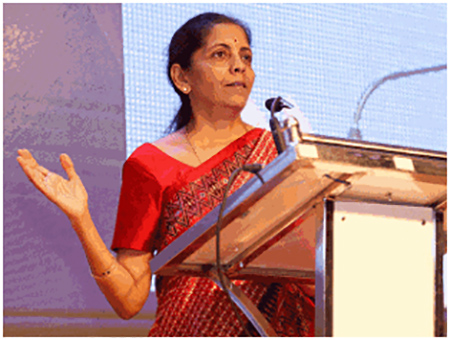 |
| The government proposes to come out with a mid-term review of the Foreign Trade Policy (FTP) 2015-20 in September, commerce and industry minister Nirmala Sitharaman said. |
| |
| |
NEW DELHI: India plans to revamp its foreign trade policy and relook at incentives to give a leg up to the export sector, which is hurt by lower global demand as well as anappreciating rupee. The government proposes to come out with a midterm review of the Foreign Trade Policy (FTP) 201520 in September, commerce and industry minister NirmalaSitharaman told ET.
“We have asked stakeholders, whoever is interested, to give us inputs,” she said. “We are looking at it in-depth and in all its details.” The foreign trade policy, announced in 2015, has set an export target of $900 billion, or about Rs 58 lakh crore, by 2020. In 201617, India’s merchandise shipments aggregated at $275 billion, or about Rs 17,70,000crore. To achieve the FTP target in five years, exports have to grow at 14% every year. “Between 2014 and today a lot has changed. Exports are happening, but globally trade is in a depressed situation,” Sitharaman said. “India went through a bad patch and is now recovering.” She will hold a day¬long consultation with the stakeholders on Saturday on FTP. Make in India will continue to be a significant factor influencing the policy. Already, the policy provides for higher level of rewards to products with high domestic content and value addition compared to products with high import content and less value addition. The government is likely to provide special incentives to a smaller list of sectors from among the 25 focus areas for the Make in India programme. Some aspects of the foreign trade policy will be modified to align in with the Goods and Service Tax, which is likely to be rolled out in July this year.
FTP 201520 had introduced two new schemes: Merchandise Exports from India Scheme (MEIS) and Services Exports from India Scheme (SEIS). These schemes replaced multiple schemes, each with different conditions for eligibility and usage. Incentives under these schemes have been made available for SEZs as well. Ecommerce of handicrafts, handlooms and books among others are eligible for the benefits.
(Ref. http://economictimes.indiatimes.com/news/economy/foreign-trade/india-to-revamp-foreign-trade-policy-to-give-leg-up-to-exports/printarticle/58540622.cms dated 5th May-2017)
|
|
BACK |
MIDTERM FOREIGN TRADE POLICY TO BE OUT BEFORE GST ROLL OUT: NIRMALA SITHARAMAN
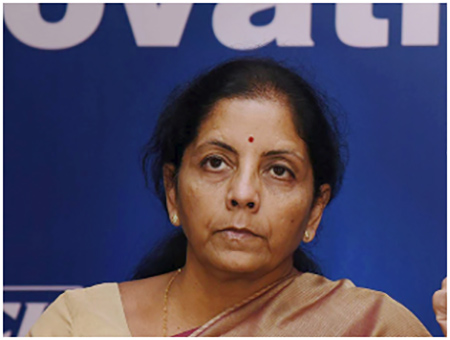 |
| "We found merit in the suggestion that the review ofthe policy should be well in time to go along with theroll out of the GST. It means I have to announce itwell in time for July 1," Sitharaman said. |
| |
NEW DELHI: Commerce Minister NirmalaSitharaman today said the revised midtermforeign trade policy (FTP) is to be announced few days ahead of July 1, the scheduleddate for the Goods and Services Tax roll out. After holding a meeting with various stakeholders, including exporters as part midterm review of FTP (201520) here, the minister also said that no suggestions were made to scale down the 2020 export target of USD 900 billion, including services. Given the current economic and geopolitical situations globally there are concerns that international trade may be impacted.
Sitharaman said suggestions were made that the review should be concluded by July 1 so that it is aligned with the GST implementation. "We found merit in the suggestion that the review of the policy should be well in time to go along with the roll out of the GST. It means I have to announce it well in time for July 1," she said. She further said that there were certain specific suggestions and questions for the GST Council comprising state finance ministers, and headed by the Union Finance Minister.
A team including the Commerce Secretary to seek time from GST Council on the specific issue, including one related to duty refunds of exporters. Exporters, especially from the SME sector, have expressed concerns that their funds would be locked up for several months. As per the GST norms, 90 per cent of the refund will be given in 7 days and remaining 10 percent will be given in 45 months. SME exporters expressed concerns that their funds could remain locked for long time. During the meeting suggestions were also made to explore rupee denominated trade especially in the South East Asian nations and those in the Middle East. Suggestions were also made that the FTP should not focus only on exports but on imports as well.
(Ref. http://economictimes.indiatimes.com/news/economy/policy/mid-term-foreign-trade-policy-to-be-out-before-gst-roll-out-nirmala-sitharaman/articleshow/58549266.cms dated 6th May-2017)
|
|
BACK |
NIRMALA SITHARAMAN SAID THAT MID-TERM REVIEW OF FTP WOULD BE COMPLETED EARLY TO SYNCHRONISE ITS ROLL OUT WITH GST
 |
| |
New Delhi: Commerce and Industry Minister Smt. NirmalaSitharaman has said that the revised Foreign Trade Policy (FTP) would be released early to synchronise the same with roll out of GST. The core focus of the revised FTP would be promoting exports from the SMEs and high employment potential sectors. Smt. NirmalaSitharaman was chairing a meeting on the Mid-Term review of the Foreign Trade Policy 2015-20 organised jointly by Department of Commerce and Research and Information System for the Developing Countries (RIS).
Commerce Secretary, Ms Rita Teaotia, Chairman RIS ShriHardeep Singh Puri and DGFT Shri Ajay Bhalla also participated in discussions. The event was attended by the trade policy experts from the industry, academia, Research and Government.
Major suggestions discussed during the deliberations related to promoting Rupee Trade, facilitating not only exports but also imports and reducing cost of credit. Participant recommended harnessing the high foreign exchange earnings and large employment generation potential of services related to the Tourism, Education and Health sector. Such services fall under the WTO category of the Mode 2 Services, also called the 'Consumption Abroad' category. It was emphasised that promotion of mode2 in services sector shall contribute in domestic economic development and job creation.
Concerns were also raised on issues relating to GST and its impact on export. Minister said that Department of Commerce has already taken up these issues with Department of Revenue, and assured that it will again take up these issues With DoR for placing it before GST council to find a solution.
Critical role of Logistics sector for export competitiveness was also discussed;, reducing the cost of credit in promoting exports, export basket diversification, strategy for promoting value added exports, agriculture exports and services exports were also deliberated.
It may be noted that while announcing the five year FTP, 2015-2020 on 01.04.2015, Hon’ble Commerce & Industry Minister had announced that the policy would be reviewed on mid-term basis. The exercise has been initiated by Department of commerce in January 2017. DGFT has held consultation with a cross section of stakeholders.- Exporters, Traders, Export promotion Councils, Commodity Boards, Various Ministries of the Central Govt., State Governments, foreign missions of India and Industry Bodies- in this regard.
(ref. https://orissadiary.com/nirmala-sitharaman-said-mid-term-review-ftp-completed-early-synchronise-roll-gst/ dated 6th May-2017)
|
|
BACK |
LENIN MORENO'S WIN IN ECUADOR LIFTS LEFTIST SPIRITS IN LATIN AMERICA
 |
| Mr. R. Viswanathan, also known as Rengaraj Viswanathan, is a retired Indian diplomat, writer and speaker specializing in Latin American politics, markets, and culture. |
| |
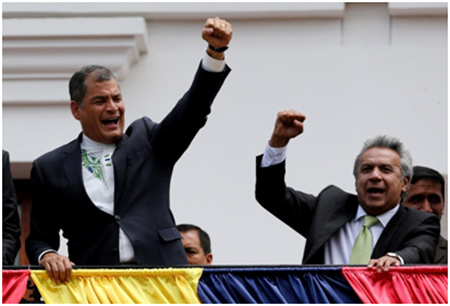 |
| Ecuador’s President Rafael Correa (L) and president elect Lenin Moreno greet supporters as they stand on the government palace’s balcony during a military change of guard ceremony in Quito, Ecuador April 3, 2017. Credit: Reuters |
| |
Leftist candidate Lenin Moreno won Ecuador’s presidential run-off elections on April 2, beating his rightist rival Guillermo Lasso, a wealthy banker.
Moreno’s victory is being celebrated by the Latin American Left, which had lost power to the right in Argentina and Peru in recent elections. In Brazil and Paraguay, the rightists have brought down leftist presidents through constitutional coups. There is talk of ‘retreat of the left‘and ‘fading of the pink tide‘in the region. Against this background, Moreno’s victory in Ecuador is a moral boost to the Left in the region. Moreno is the hand-picked candidate of leftist President Rafael Correa, who has ruled the country since 2007. The outspoken Correa is known for his fierce crusade against neoliberalism and Washington Consensus. He had refused to sign a FTA with the US, pulling out of the negotiations even when neighbours Colombia and Peru went ahead. He closed the US airbase in Ecuador when the lease expired in 2009. In a bold move, he granted asylum to Wikileaks founder Julian Assange who is wanted by US prosecutors after he had published secret American documents; Assange has been staying at the Ecuadorian embassy in London since June 2012. Lasso threatened to evict Assange if he won the election.
The victory of the Left in Ecuador comes as a relief and brings hope for those frustrated with the recent rise of right-wing extremism in Europe, US and other parts of the world. It should not be forgotten that the Left continues to rule in Bolivia, Chile, Uruguay and Venezuela. Former president LuizInácio Lula da Silva is still seen as the frontrunner in Brazil’s next elections in 2018, if he is not banned from running through right-wing conspiracy. The chances of Mexico’s leftist candidate, Andrés Manuel LópezObrador, have become brighter in the elections next year as a reaction to US President Donald Trump’s anti-Mexico diatribes.
The credit for the victory of the Left in Ecuador goes to the exemplary performance of Correa’s government in the last ten years. Correa has pulled the country out of its economic mess of the past when it suffered one crisis after another. He has reduced the poverty rate from 40% in 2006 to 23% in 2016. He has doubled the social spending, improved the living standard, and infrastructure and public services. He has included Ecuador’s indigenous people and other marginalised groups in political and economic development. He achieved all these without stoking inflation, which stood at 1.3% in 2016. Under his government, economic growth increased steadily while unemployment decreased. He redrew the unequal oil and mining contracts of multinational corporations, making them pay more, and using the additional revenue for education and healthcare. Alarmed by the fact that 38% the government revenue went to service external debt, he cut it down by aggressive and compulsory restructuring, and by standing up to IMF, World Bank and the western creditor mafia. While his close friend Hugo Chavez ruined the Venezuelan economy with disastrous policies in the name of ‘twenty first century socialism,’ Correa, who has a masters and PhD in economics from a US university, showed pragmatism. For instance, he continued the policy of his predecessors in keeping the US dollar as the country’s currency as part of economic stabilisation, despite his anti-US rhetoric and his own criticism of dollarisation when it was introduced in 2000.
More importantly, Correa brought political stability to Ecuador, notorious for its chronic instability. The country had seen eight presidents in the ten years before Correa came to power, witnessing military coups and congressional impeachments of presidents in that period. Three of Correa’s predecessors were forced out of office before completing their terms. Correa is the first president elected to serve a third consecutive term in the last 100 years of Ecuador’s history. After his first election in 2006, Correa got a new constitution approved in 2008, under which he won re-election in 2009 and 2013. Correa is leaving the presidency honourably with his head high and a respectable approval rating of 44% after ten years in power. He has announced that he will pursue academic work in Belgium, where he had done university studies and met his wife Anne Malherbe.
Moreno, who had served as vice president during Correa’s first term (2007-13), has promised the continuation of Correa’s inclusive agenda of development. He is more moderate and conciliatory than his sharp-tongued and thin-skinned combative predecessor who was intolerant of criticism. Moreno is a paraplegic since being shot during a robbery in 1998. He had used ‘laughter therapy’ as part of his recovery process and has created a foundation, Eventa, to promote humour and joy as a way of life, authoring numerous books on the subject.
Lasso, who lost narrowly with 48.83% of the vote, as against Moreno’s 51.17 %, is contesting the results claiming irregularities. He has asked his supporters to protest peacefully but forcefully. But he is yet to come out with solid evidence to substantiate his allegations. The external observers sent by the Organisation of American States (OAS) and UNASUR (South American community of states) have not reported any adverse observations on the polls. In fact, the secretary general of OAS has already congratulated Moreno for his victory. It may be noted that Lasso got 10% fewer votes than Moreno’s 39.36% in the first round of elections held in February. His party CREO got just 34 seats while Moreno’s Alliance Pais (Country Alliance) party had won 74 and secured a majority in the 137-member National Assembly in the February elections. Lasso had also lost to Correa in the 2013 presidential election, getting just 22.7% vis-à-vis Correa’s 57%.
Ecuador, a small country with a population of 16.4 million and $100 billion GDP, depends largely on oil exports for its revenue. With the drastic decline in oil prices in the last two years, the country faces problems of budget deficit, foreign exchange shortage and austerity. The GDP growth in 2017 is projected to be just 0.3% after the contraction of 2% in 2016. The country is in deep debt to China, which has given a cumulative credit of $17.4 billion. The Chinese are taking oil against repayment and are dominating in Ecuador’s oil, mining and infrastructure sectors. The excessive dependence on China for credit and investment is the price Correa had to pay in view of the hostile and high-handed approach of Western financial institutions.
India’s trade with Ecuador was $378 million in 2016 (January-December), of which exports were $165 million and imports $213 million. India’s imports have fallen drastically from $987 million in 2014, due to the fall in price of crude, the country’s main import. Ecuador is an OPEC member with an estimated 8 billion barrels of proven reserves and daily production of 540,000 barrels. TCS has implemented a $150 million IT project for Ecuador’s Banco Pichincha, which is one of their largest contracts in the region. India had exported seven Dhruv helicopters to Ecuador but four of them crashed. The delay in amicable resolution of this issue has caused some strain in bilateral relations. In spite of this, Ecuador is keen to strengthen trade with India and attract Indian investment. It had sent a large business and government delegation, led by the vice president, to the Indo-LAC Business Conclave in December 2013. Petro Ecuador has signed a MOU with ONGC Videsh Ltd for cooperation in hydrocarbons. Ecuador has established a consulate in Mumbai besides an embassy in New Delhi. This is noteworthy given that Brazil and Argentina are the only other Latin American countries with consulates in Mumbai.
It is time for India to consider opening an embassy in Quito. Ecuador is more important than Iceland, where India has an embassy for unknown reasons. India’s exports to Iceland are less than $20 million and imports below $5 million. After all, the cold and barren Iceland, with a tiny population of 330,000 and an insignificant GDP, does not have oil, minerals or opportunities like Ecuador does.
|
|
BACK |
LATIN AMERICAN GDP PROJECTED TO GROW BY 1.1% IN 2017
|
Latin America is projected to have a GDP growth of 1.1% in 2017, according to the 24 April report of the UN Economic Commission for Latin America and Caribbean (ECLAC). This latest growth estimate is less than the prediction of 1.3% in ECLAC's December 2016 report.
Even the 1.1% growth comes as welcomenews; given the fact the region had suffered an economic contraction of 1.1% in 2016 and 0.5 % in 2015.
South America is expected to have a low growth of 0.6% while Central America will have a higher rate of 3.6%
Growth estimates for the major countries are as follows:
- Brazil 0.4%
- Mexico- 1.9%
- Argentina 2%
- Colombia- 2.4%
- Peru- 3.5%
- Chile- 1.5%
Dominican Republic will be the region's growth champion in 2017 with 5.3%, followed by Panama at 5.2%, Nicaragua at 4.6% and Bolivia-4%.
Venezuela is likely to suffer yet another economic contraction at 7.2% in 2017. The country is in a hopeless free fall. Its only hope is change of the Chavista regime which has no clues to stop the economic deterioration. The country is heading towards a political explosion and economic collapse.
The recovery in the global prices and demand of commodities should help South America to hope for a higher growth in 2018.
Brazil, the biggest economy faces internal problems while Mexico, the second biggest faces external challenges. Brazil is lurching from one political crisis to the next and is coming out with more and more incredible scandals of corruption. Earlier this month, the Supreme court has authorized investigation of 108 politicians which include nine ministers in President Michel Temer's government, three state governors, 29 senators and 42 members of the lower house of Congress. Consequent to this, the corporate activities are paralyzed, bank credits frozen, infrastructure projects delayed and investments postponed. The Odebrecht corruption scandal has claimed victims in Colombia, Peru and other Latin American countries. China is taking advantage of the situation and buying up assets whose prices have come down due to the economic crisis. In the first four months of 2017 the Chinese have invested 5.7 billion dollars in Brazil. Last year they invested 11.9 billion dollars and they are the largest foreign investor in Brazil.
The Brazilian situation has an adverse impact on Argentina which is finding it difficult to grow faster as expected under the business-friendly Macri government.
Mexico faces challenging times with Trump's threats to build a wall, repatriate illegal Mexicans in US and change NAFTA to favor US more. Foreign investors have become more cautious about investing in Mexico which was emerging as the ' manufacturing hub' of Americas, becoming even more competitive than China in some manufacturing sectors such as cars and appliances.
Peru and Colombia are the countries which show promise of higher growth. Being a larger market, Colombia should be considered as the best opportunity for business in the region.
|
|
BACK |
EMULSIFIERS: MICRO TECHNOLOGY WITH MACRO EFFECT
|
Introduction
Water and oil, when mixed together and vigorously shaken, form a dispersion of oil droplets in water. Once the shaking stops, the phases start to separate. However, when an emulsifier is added to the system, the droplets remain dispersed, and a stable emulsion is obtained.
An emulsifier consists of a water-loving hydrophilic head and an oil-loving hydrophobic tail. The hydrophilic head is directed to the aqueous phase and the hydrophobic tail to the oil phase. The emulsifier positions itself at the oil/water or air/water interface, and has a stabilizing effect on the emulsion by reducing the surface tension.
Major Applications
- Food Industry: An emulsifier is well known in the food industry for its emulsifying effects, where it serves various functions. Following are some examples of the use of emulsifiers in the food industry:
- Modifies oil crystal and prevents water spattering in cooking
- Destroys emulsion to stabilize foam and to make smooth texture in ice cream, and keeps its shape
- Reacts with proteins to make smooth easy-rising dough in bread
- Acts on starch to make bread soft
- Personal Care Industry: Emulsifiers are an important category of surfactants for personal care applications. They are essential in the production of creams and lotions. Emulsifiers enable oil and water/aqueous components to mix and remain stable over a long period of time. Choosing an optimum emulsifier system helps create evenly dispersed, small droplets, thus providing kinetic stability and an elegant texture, skin feel and appearance to creams and lotions. Typically, emulsions have a milky white, opaque appearance due to the type and level of emulsifiers used; however, there are micro emulsions that appear clear or transparent to the human eye. These are used in specialized applications, such as enhancing skin permeation of active substances. Emulsifiers often impart a specific texture or sensory aspect to the end product, so their selection is important for marketing appeal as well as technical aspects.
Current Market Scenario
The global emulsifiers market is expected to grow at a CAGR of 5.28% between 2016 and 2021. Factors contributing to the market growth include increasing popularity of natural emulsifiers and growing usage of emulsifiers in personal care products and the food & beverage industry. Technological advancements within the food processing industry are expected to further boost the market growth. Factors such as increasing demand for packaged food, escalating income levels and availability of packaged functional foods are boosting the demand for emulsifiers. However, consolidation within the food additive industry is expected to restrain the market growth.
Among all the products, lecithin represents the largest share in the emulsifiers market. Lecithin is used widely in feed, food, nutritional supplements and cosmetics. The United States represents the largest market worldwide, whereas Asia-Pacific is projected to grow at the highest CAGR due to sustained demand for natural emulsifiers.
Some of the key players in the emulsifiers market include Cargill Inc., Lonza Group, BASF, AAK Bakery Services Ltd., DSM Nutritional Products, DuPont, Lubrizol Advanced Material, Danisco A/S, Archer Daniels Midland Company, Dow Corning Corporation, Palsgaard A/S, Stepan Company, and Kerry Group.
Recent Developments
Emulsions are a fundamental product form for many cosmetic categories, which involves careful selection of optimum emulsifier systems. Cosmetic science has progressed a long way and at present there is a trend towards liquid crystal structures and emulsifiers that are acceptable and usable to manufacture certified natural cosmetics.
- Alfa Chemicals worked on emulsifier technology and developed an emulsifier with a trade name of Sucragel AOF BIO, which is a natural liquid emulsifier based on sucrose laurate. It can be used in the oil phase as a co-emulsifier for creams and lotions. It can also be used to gel oils, which can then in turn be diluted with water to form a fine sprayable emulsion.
- Azeis Personal Care developed emulsifier-based products, such as BlanovaMuls GMSC, BlanovaMuls Eco 77, and BlanovaMuls Eco 2277 Eco, among others. For example, BlanovaMuls GMSC is glyceryl stearate citrate based emulsifier, which is used to emulsify high amounts of oil. It is particularly suitable for the production of sprayable emulsions.
- Croda's new product formulations based on emulsifier technology include Arlacel 1690, Arlacel 2121, NatraGem E145 and NaturGem E140. These products are developed in order to cater to the growing demand from the cosmetic industry. For example, NatraGem E145 is a natural emulsifier, which is compatible with both low and high polarity oils with excellent electrolyte, pH and temperature tolerances.
- Dow Corning developed DC ES-5612 Formulation Aid, which is a silicone emulsifier designed to prepare low viscosity water-in-silicone and water-in-oil emulsions.
Costs
Emulsifiers are generally cost extensive to manufacture and process, owing to the high raw material costs associated with them. Emulsifiers significantly increase the cost of product in which they are added. Occasionally the cost of their formulation is almost doubled by their addition. However, owing to advancement in technology, natural raw materials based emulsifiers are being developed, which are not only of higher quality, but are also relatively cheaper. For example, a new starch emulsifier developed by Ingredion can deliver four times the emulsifying power of traditional beverage emulsifiers, enabling manufacturers to slash production and distribution costs.
DISCLAIMER:-
Mordor Intelligence Reports and their contents, including all the analysis and research containing valuable market information, are provided to a select group of customers in response to orders. Our customers acknowledge when ordering that Mordor Intelligence strategic analysis services are for their customers’ internal use and not for general publication or disclosure to third parties.
Quantitative market information is based primarily on interviews and therefore, is subject to fluctuation. Mordor Intelligence takes no responsibility for any incorrect information supplied to us by manufacturers or users.
No part of this strategic analysis service may be given, lent, resold or disclosed to non-customers without written permission. Reproduction and/or transmission in any form and by any means including photocopying, mechanical, electronic, recording or otherwise, without the permission of the publisher is prohibited.
ABOUT US
Mordor Intelligence is a global market research and consulting firm. For information regarding permissions and sales, please contact: info@mordorintelligence.com
|
|
BACK |
|

